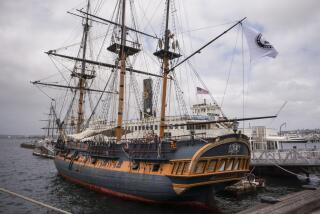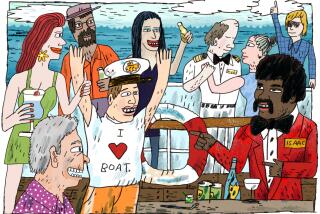Down to the Sea in Sarongs and the Wind Song
- Share via
BORA BORA — The three scantily clad young Tahitian women watched the European sailors slosh ashore from their small boat, hauling food and supplies across the sand and up to a sheltered grassy area under the coconut palms.
The Europeans tried not to stare as the girls giggled and preened, stretching their arms and tossing back their long, wet black hair like mermaids.
It could have been 1767, when an officer aboard the first European vessel to arrive in Tahiti described being met by canoes filled with young women “who played a great many droll, wanton tricks.”
Instead it is 1987, and the sunbathing Tahitians, secretaries from Papeete on vacation, were playfully bedeviling young crew members from the Wind Song, the newest cruise ship sailing the waters of French Polynesia.
Later the Tahitians, their sarongs demurely adjusted after they left the beach, accepted an invitation to lunch. That evening, transformed into their urban selves in high heels and sophisticated French-label summer dresses, they trooped eagerly aboard the Wind Song for a look around.
Mainmast Attraction
Whether docked in Papeete or anchored in beautiful Cook’s Bay in Moorea, the dramatic four-masted, 440-foot ship holds its own against the scenery. Although the 150-passenger vessel--whose sails are set and trimmed by computers operated from the bridge--looks at home in these timeless islands and turquoise lagoons, it would dwarf early predecessors like Capt. William Bligh’s Bounty or explorer James Cook’s Endeavour.
Still, for passengers on board there is an undeniable connection with those early explorers, especially when the ship sails into Bora Bora in the early morning with the steep green peaks of the twin mountains Pahia and Otemanu still wreathed with misty chiffon clouds, or when it lies at anchor in Cook’s Bay below the Moorea peak called Bali Hai.
While the ship offers an around-the-island tour on an open-air Le Truck in Bora Bora, many of the energetic Wind Song passengers rent bicycles for the mostly level 22-mile circuit along the sometimes-paved roadway, stopping off for a lunch break at the beach barbecue before pedaling on.
Participants in a shark-feeding outrigger cruise discovered that only small fish are fed. The sharks soon show up to feed on them, and the passengers in snorkel masks cling to a rope and watch the underwater action.
Said one woman later: “They told us that the sharks won’t come past the rope.”
Mixed Reception
The sleepy islands of Huahine, Tahaa and Raiatea have even less overt interest in tourists than the better-known laid-back hideaways of Bora Bora and Moorea. On Tahaa, in fact, in the village of Tiva, one of the two Chinese stores closed its doors when they saw a handful of passengers come ashore from the ship’s launch.
Most of the people on board had gone snorkeling at a nearby motu (coral island), but the remaining dozen spent 30 minutes strolling the solitary unpaved street--looking at pigs and chickens, browsing through the store where cans of cassoulet shared shelf space with Coleman lanterns, and watching a girls’ volleyball match, the only game in town.
We had 135 passengers on board, young-to-middle-aged North American couples, many from California; a young West German couple who live and work in China; a chic Italian pair with their pretty college-age daughter; several French couples in their 30s, and 20 youngsters between the ages of 10 and 18. For many it was both their first cruise and first visit to the South Pacific.
They were avidly interested in water sports, and took part in everything from snorkeling and scuba diving to water skiing and windsurfing. A few grumbled when only one of the ship’s inflatable boats was used to shuttle passengers to a nearby motu for snorkeling or tow the skiers around Cook’s Bay. They were told there was only one driver at present qualified to maneuver around the treacherous coral reefs.
Easygoing Evenings
After so much activity all day, it’s hardly surprising that no one stays up late. Each cabin has a VCR, and the ship’s closed-circuit TV plays three channels of feature films all day and evening.
Bar prices on board, while moderate compared to Tahitian shoreside rates, are still steep compared to most cruise ships, with a glass of house white wine going for $3.50, a glass of champagne for $7, beer for $3 and cocktails $3 to $4.
The food aboard ranks with the top three or four ships in the cruise world, thanks to chef Johannes Moser’s tireless efforts to provide passengers with fresh fish, fruits and vegetables from the islands. Service from the European staff in the cabins and dining areas is exceptionally good; tipping is not required.
The inevitable comparison between the Windstar ships and the Sea Goddess ships, both small, luxurious and expensive, came up during the cruise. One staff member who has worked on both commented that Windstar passengers “do not expect to dress up; they have come with the attitude that they don’t have to, whereas on Sea Goddess, they come expecting to dress for dinner.”
‘Casual Elegance’
The dress code specifies “casual elegance” for the evenings, which most men interpreted as short-sleeved sport shirts or polo shirts without jackets.
The unstructured informality unfortunately also slops over into parts of the cruise that should be more orderly--the lifeboat drill and the shore excursions program, for example. There are no clearly defined smoking and nonsmoking areas in the dining rooms or lounge at present.
This is the second of three state-of-the-art motor/sailing vessels built in Europe for Miami-based Windstar Sail Cruises. The first, Wind Star, made its debut in the Caribbean last December, and the third, Wind Spirit, is expected to arrive in the Mediterranean next spring for seven-day cruises from a Venice base.
The few shakedown problems we noted on the Wind Star’s debut last winter have been corrected on this ship.
Fares for the seven-day cruises in French Polynesia through the end of 1987 are $2,635 per person, double occupancy, with a round-trip add-on air fare that ranges from $450 for San Francisco and Los Angeles to $790 for New York and Miami.
More to Read
Sign up for The Wild
We’ll help you find the best places to hike, bike and run, as well as the perfect silent spots for meditation and yoga.
You may occasionally receive promotional content from the Los Angeles Times.






